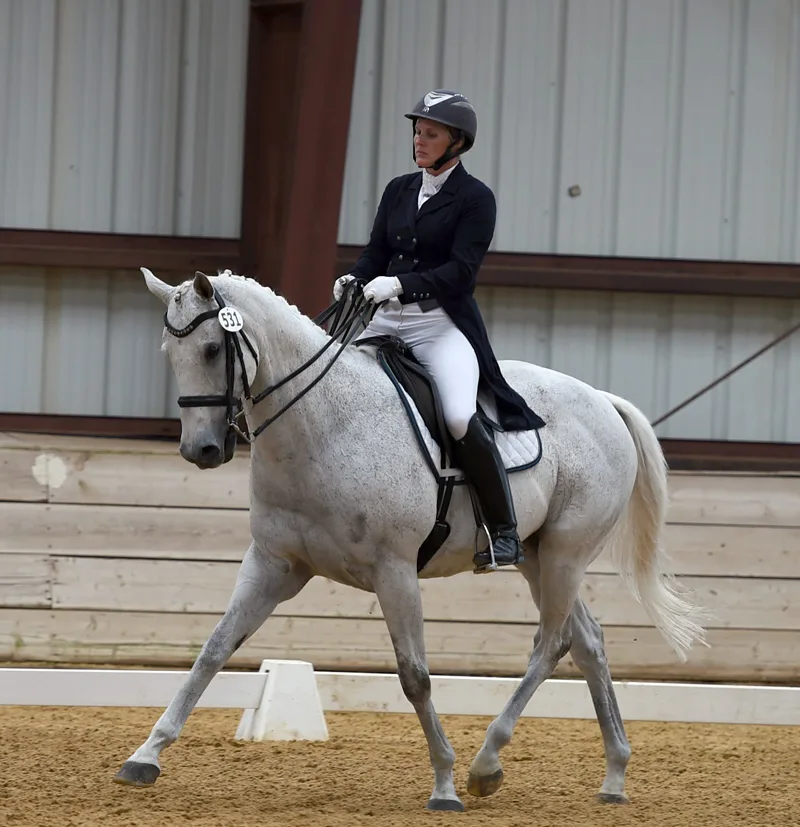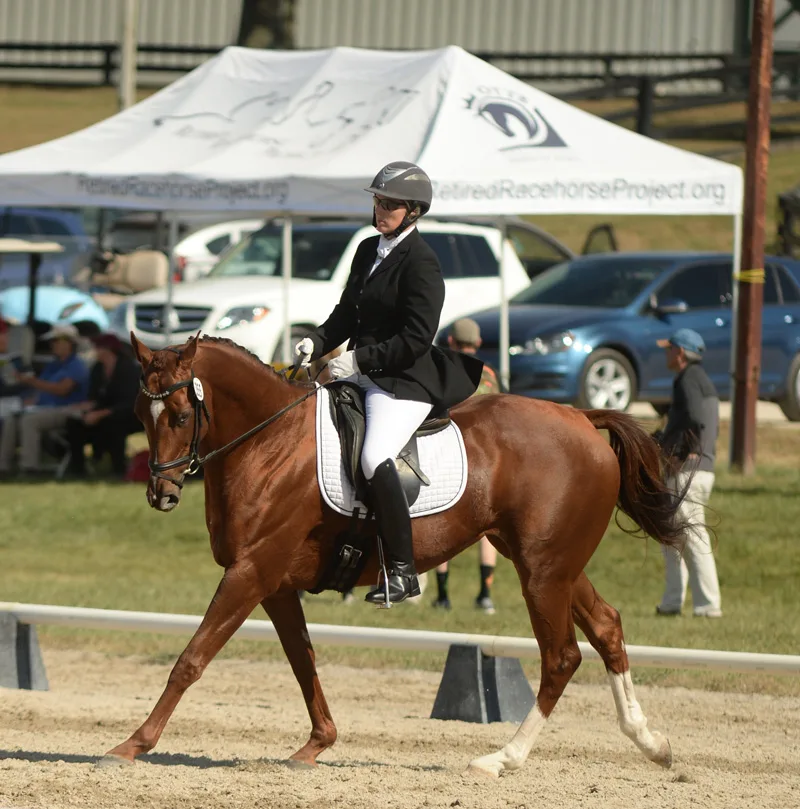Jenny Spain is the first to admit that she didn’t start riding off-the-track Thoroughbreds by choice.
“The reality is I probably got into it because it’s what I could afford,” Spain said. “I never had money to buy a horse, not as a kid and not as an adult. But wherever you are in the country, Thoroughbreds are pretty common, and they’re pretty cheap. That always fit the bill for me.”
Spain, 41, grew up riding jumpers in Chesterfield, Virginia, where she worked every day after school to pay down the bill for her lessons and her first horse. Starting in 10th grade, she left her brick-and-mortar high school to home school herself, opening up even more hours to spend at the stables.

Jenny Spain has learned to love dressage with her off-the-track Thoroughbred Turnaround Tony. Pics Of You Photography Photo
Spain kept riding through her post-secondary education, first at St. Andrews Presbyterian College (North Carolina) where she earned a bachelor’s degree in business administration, then at Wake Forest University (North Carolina) during her master’s program in communications.
She took a semester off after her sophomore year to groom for Sulu Rose-Reed in Ocala, Florida, and Goochland, Virginia, before deciding the professional competition circuit wasn’t for her.
“I always wanted to do something with horses, but I also realized that I didn’t want to be a groom my whole life,” Spain said. “I didn’t think I was a good enough rider to be a professional rider; to me, a real professional needs to be the best. I could teach people lower-level stuff, but that wasn’t exactly what I wanted to do, either.”
Spain found the career she wanted in an unexpected place: the therapeutic riding community, which has a strong presence in the town of Wake Forest, North Carolina. For her master’s thesis, Spain researched the verbal and nonverbal communication that happens during a therapeutic riding lesson. She observed lessons at a local riding center and tracked each interaction in which the student engaged—with the horse, with the volunteer assisting them, and with the instructor.
“Basically, what I found was that the number of interactions that happen in the lesson are directly correlated to the instructor and how good they are at initiating activities,” Spain explained. “The horse and the volunteer didn’t make much of a difference. As the quality of instruction increased, the number of interactions all around went up. And that’s extremely important.”

Jenny Spain and her young off-the-track Thoroughbred Some Caan Job are moving up the levels in dressage. Photo courtesy of Jenny Spain
Spain gave the example of an instructor directing a student to pet their horse. Without the suggestion from the instructor, the rider wouldn’t think to do it. But given the command, the student engages with the horse by reaching forward, with the volunteer who offers encouragement, and with the instructor, who gives the directive and praises the effort.
“It really made a strong case to me for the importance of quality, knowledgeable instruction,” Spain said. “After graduation, I got a job at a therapeutic center in Northern Virginia through a friend. A few years after that, I ended up co-founding a program.”
ADVERTISEMENT
Spain opened Simple Changes 15 years ago with friend Corliss Wallingford. She helped institute a scholarship fund for equestrian professionals who want training in therapeutic instruction because Spain is convinced that the best therapeutic coaches are people who both know horses and understand the art of teaching a good lesson.
As program director, she stays busy with fundraising and bookkeeping in addition to her time coaching in the arena. But she enjoys the variety.
“It can be a good way to make a living,” Spain said. “You’re never going to get rich, but you can have benefits. I get bored doing the same things all the time, and running a program like this, there are a lot of hats you have to wear. Even just teaching, you know that no two riders are the same—in fact, in therapeutic riding, they can be very, very different. And I’m fortunate in that although it can be very demanding, it still gives me the flexibility to ride my own horses.”

Jenny Spain (right) has enjoyed learning about dressage thanks to her wife Melinda Freckleton, pictured with their daughter, Clara Freckleton-Spain. Lita Trimmings Photo
Spain’s riding changed dramatically soon after moving to Northern Virginia when she met her wife, Melinda Freckleton, DVM, who worked as her veterinarian before they started dating. Freckleton rode dressage and convinced Spain to give it a try.
By the time they bought their own farm in Catlett, Virginia, Spain was converted.
“I realized there was more to it than just going in circles,” Spain admitted with a laugh. “It’s really hard and really fun.”
Spain had retired her college jumper Graystone, whom she’d ridden in the amateur-owner jumper division, to a job at the therapeutic riding center, so she started casually looking for a dressage prospect. Her wife suggested an OTTB that a friend had in the pasture. At 7 years old, the gelding could barely canter with a rider in the saddle, but his name was Turnaround Tony, and Spain decided to take a chance.
Spain had shown up to second level, but retraining an OTTB for dressage presented a new challenge.
“I would say the hardest part of retraining an OTTB is when they get tense,” Spain said. “When something makes them nervous, it can be difficult to work through it because they just go into tight, leap-around horse mode. They’re not particularly forward horses unless something makes them tense; then they become a ball of explosive energy. So you just have to figure out what helps diffuse them.”
For help working through the tension, Spain turned to Patrick Tigchelaar, without whom she says she “couldn’t have gotten anywhere.” The Dutch-born trainer coached from the ground as Spain and Tony (Belong To Me—Glamour Girl, Black Tie Affair), now 17, climbed the levels.
ADVERTISEMENT
In 2017, they rode their first Grand Prix.
“It went OK,” Spain said. “Not where it needed to be, but not an embarrassment either. I had never ridden the Grand Prix, either, so it is a big jump for both of us even from I2. In the last two years, he has scored up to a 59.56 percent, and we need two scores at 60 percent [for our USDF gold medal], so it is within reach!”
People have been impressed and excited to see an OTTB practicing piaffe and passage. At shows, Tony is rarely the only Thoroughbred Spain sees.
“It’s really neat the stuff that [Retired Racehorse Project’s] Thoroughbred Makeover and other Thoroughbred groups are doing to promote Thoroughbreds for second careers; they’ve really shown how versatile they can be,” Spain said. “There will always be people who say, ‘Oh, Thoroughbreds can’t do this or can’t do that,’ but I think in general people and judges and trainers are seeing how far they can go. If the horse wants to, of course. The trick is developing an eye for the right horse.”
Given her success with Tony and years of practice riding Thoroughbreds, Spain decided to give the Thoroughbred Makeover (Kentucky) a try. In 2016, she bought a 3-year-old mare, Some Caan Job (“Annie”), and the pair claimed fourth in the dressage division at the Makeover the following year.
Unlike many horses at the Makeover, Annie’s experience in the program with Spain marked only the first step in her training pipeline.
“I didn’t go into it thinking, ‘Oh, let me flip this horse.’ I’m looking for my next Grand Prix horse!” Spain said. “She’s showing second level this year and hopefully will move on up to third next year. She’s younger getting started and more naturally talented than Tony, so I’m hoping she’ll make it to FEI, too.”
This fall, Tony had all his incisors removed due to equine odontoclastic tooth resorption and hypercementosis. Despite that, he’s been schooling better than he was before and pulls his tongue in when he’s doing collected work.
Spain can’t say for sure that he’ll return to Grand Prix, but she’s hopeful. Not because he’s the most gifted horse she’s ever ridden or even the most resilient. But because she knows he’ll try.
“Thoroughbreds really fight hard for you,” Spain said. “The three I have, the only reason that they can do the things they do is because they try. Frankly, I would rather have one that tries hard than one that’s extremely talented. I’ll take my Thoroughbreds any day.”
Do you know an amateur rider with a cool story? If so, email Lindsay at lberreth@coth.com for a chance to be featured on coth.com.















